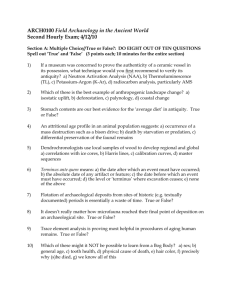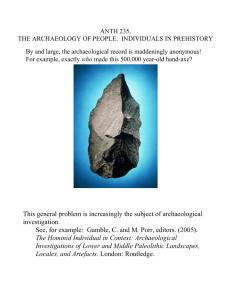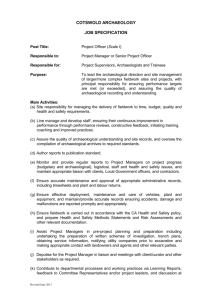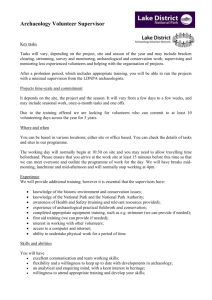Further Information
advertisement
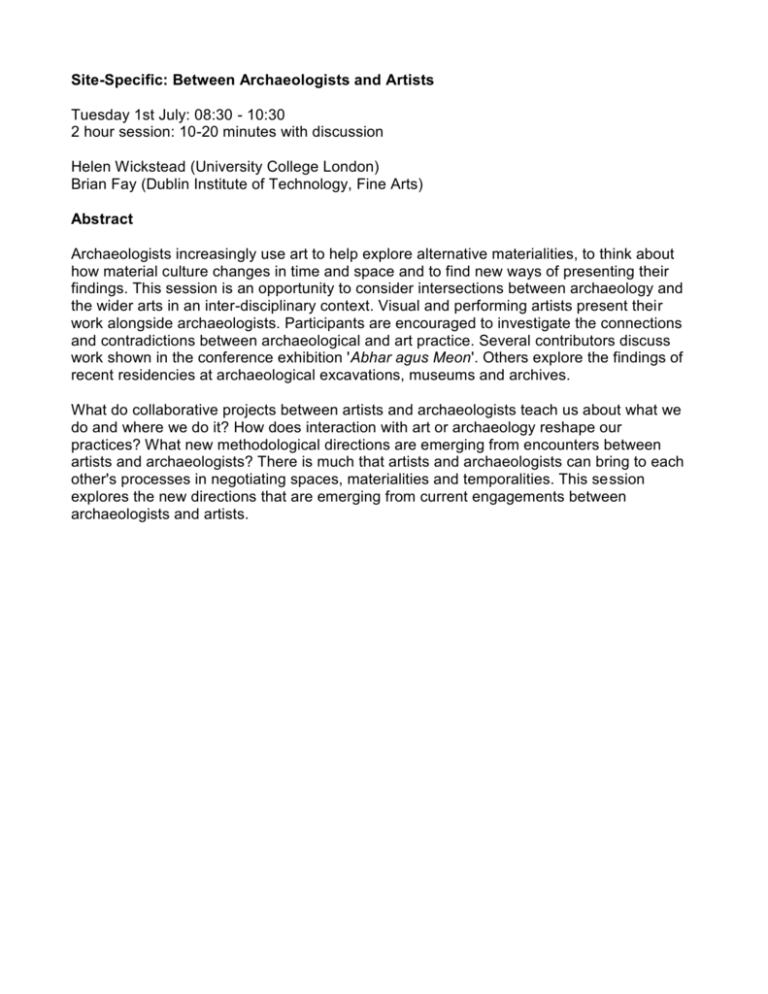
Site-Specific: Between Archaeologists and Artists Tuesday 1st July: 08:30 - 10:30 2 hour session: 10-20 minutes with discussion Helen Wickstead (University College London) Brian Fay (Dublin Institute of Technology, Fine Arts) Abstract Archaeologists increasingly use art to help explore alternative materialities, to think about how material culture changes in time and space and to find new ways of presenting their findings. This session is an opportunity to consider intersections between archaeology and the wider arts in an inter-disciplinary context. Visual and performing artists present their work alongside archaeologists. Participants are encouraged to investigate the connections and contradictions between archaeological and art practice. Several contributors discuss work shown in the conference exhibition 'Abhar agus Meon'. Others explore the findings of recent residencies at archaeological excavations, museums and archives. What do collaborative projects between artists and archaeologists teach us about what we do and where we do it? How does interaction with art or archaeology reshape our practices? What new methodological directions are emerging from encounters between artists and archaeologists? There is much that artists and archaeologists can bring to each other's processes in negotiating spaces, materialities and temporalities. This session explores the new directions that are emerging from current engagements between archaeologists and artists. Contributor Abstracts The curse of the cursus Mark Anstee (www.markanstee.com) Abstract Stone upon broken stone Leo Duff (Kingston University London) Abstract My art practice explores the materiality of stone through drawing. In this paper I discuss several previous projects which research the use and reuse of stone in the built environment. I present works which analyse and respond to the construction and deconstruction of residential areas, rural and urban, in Northern Europe and South East Asia. Stone, quarried and dressed, used in the erection of dwellings then laid to waste to be refound and reused at a later date is practical and typical of areas of Ireland and England. Stone taken from mountains and placed in the city is common, and deeply meaningful, in Korea and Taiwan. My work examines and interprets, visually, the movement of stone, and the loss and recovery of stone as object and meaning. My most recent project, at Stonehenge, England, has engaged with archaeology to develop these themes. Finding time - drawing in art and archaeology Brian Fay (Dublin Institute of Technology) Abstract Having recently been an artist on the Stonehenge Riverside Project, I became aware of the centrality of drawing to an archaeological dig. The purpose of this paper is to look at drawing practices related to the issues of time, verification and the mapping of a cultural object in archaeology. Based initially on my own art practice, which employs different drawing technologies to record and mark time and history, I wish to discuss specific theories of time as a simultaneity of presents as proposed by Bergson, Husserl and Deleuze. This inquiry will be opened out to explore other drawing practices that raise questions on: the role of time in drawing the nature of 'truth' in drawing how drawing stands up to notions of verification Time machines Janet Hodgson (Birmingham City University) Abstract Archaeology and film are engines of time. They both involve processes that can be said to produce temporalities. This paper will look at the broad range of my practice as a sculptor and film maker dealing with sites and their histories. I focus in particular on work made during two residencies, one with the Canterbury Archaeological Trust, the other with the team currently excavating around Stonehenge. The multi media video installations that excavate histories from sites treat the language used as non-transparent, it is the place from where meaning and histories are both viewed and generated. Artistical practices and archaeological practices: a contemporary historical overview. Michael Jasmin (artist and archaeologist - http://www.michaeljasmin.org/) Archaeology is very related to its practice - excavation - and for a long time it has been present in the collective imagination through literature, movies... So one can be surprised that archaeology only very recently appeared in the field of contemporary art: it is mostly since the 1990s that several artists started using the excavation process in their creative practices. The use of strong symbolic archaeological practices: inearthing, excavating, and museographic mise en scene, are remarkable or central in the works of contemporary artists as Marc Pessin, Cho Duck-Hyun, Beauvais Lyons, Richard Purdy, John J. Leanos or Joan Fontecuberta and Mark Dion. Through these examples I will examine the artists' and public view of the archaeological procedure: from survey to excavation then to representation and exhibition. These creative approaches will allow me to address several methodological problems such as: - the analogy between artistic practices and the archaeological practices. - "mock sciences" approaches of archaeology. - artistic creation vs. scientific fake. - the game of artists with exhibition rules. Making connections: mutual inspirations of archaeology and art John Jameson Jr. (U.S. National Park Service) Abstract As an interdisciplinary field of study that investigates the past by analyzing evidence from material culture, with the object of predicting human behavior, archaeologists have attempted to recognize and define “artistic” objects and their associated values. In doing so, we strive to move beyond utilitarian explanations and explore the interpretive potential of cognitive imagery that archaeological information and objects can inspire. In partnership with professional interpreters and educators, we use the power of artistic expression to convey archaeological information and insights to the public. What we have termed "interpretive art" has been used successfully in paintings, drawings, educational posters, reports, popular histories, and Web presentations as ways of engaging, informing, and inspiring the public about the value of archaeology. Conversely, artists are inspired by engagements with archaeologists and archaeological objects and settings. This paper explores processes of mutual engagement that result in new understandings of inherent meanings and significance. The Transformations project: bringing forth landscapes Goncalo Leite-Velho (Instituto Politécnico de Tomar) Abstract This project (financed by the European Commission’s Culture 2007 programme) deals with artistic transformations of the landscape. It involves institutions from 7 European countries (Portugal, United Kingdom, Ireland, Latvia, France, Spain and Italy). Art is understood here in a broad sense, involving fields from Architecture, Archaeology, Landscape Modelling, Performance and Installation Art. The artworks range from LandArt interventions, to sculptures, installations and Performance art.The aim of the project is to illustrate the “Hervorbringen” (Heidegger 2002 “bringing forth”) that is connected with the action of being, introducing new spaces that can also be used for the purposes of economic development and the general welfare of the community. Close attention will be paid to the connection with the existing heritage through an interplay of meanings that overcome the constrains of past, present, future. The record: documenting archaeologists at work through drawing Julia Midgley (Liverpool School of Art & Design, Liverpool John Moores University) Abstract Documentary drawings, unlike documentary photography, attempt to capture minutes and hours as opposed to fractions of a second. Archaeological excavations graphically expose the passage of time through centuries. Archaeologists' drawings record the physical effects of passing time, the documentary artists’ drawings record live action. The decision to employ graph paper as a medium for most of the Stonehenge Riverside Project pieces attempts to reflect a common respect, medium, and interest, engendered between two disciplines. The careful notation demanded by graph paper became increasingly relevant as the artist observed. Working practice adjusted to absorb the new knowledge. Hard pencils drew on graph paper but were used in a freehand gestural manner graphically contrasting archaeologists’ techniques. Chalk was picked from the ground, a pencil sharpened with flint. All participating professionals engaged in a daily dialogue, learning, watching, exchanging and absorbing new knowledge. Performing the Museum: in situ:'s 'Without History' Bella Stewart (In situ performing arts company) Abstract In 2002, my company, in situ:, created and performed Without History in the Cambridge University Museum of Archaeology & Anthropology. The performance can be seen as a ‘creative response’ to the museum, a piece of work that could not exist without the place it was in. In this paper, I will describe what happened, perhaps with some pictures, and talk about performance as a mode of enquiry and a way of seeing things. Without History became a relationship with the museum, placing performance within a network of practices through which bodies, objects and memory are engaged in attempts to imagine both ourselves and others. Performance in the context of museums is often characterised as a ‘bringing to life’; here it is closer to a dialogue with our mortality. Our future tends to be prehistoric: 'Atacama Lab:07' Flora Vilches (Universidad Católica del Norte) Abstract This paper discusses the recent interdisciplinary project “Atacama Lab:07”, led by professor of architecture and design, Chris Taylor and organized by INCUBO in northern Chile. The project is based upon the field study program “Land Arts of the American West” that Professor Taylor runs in the USA (UT-Austin), which aims to investigate the overlay of land art practices from pre-contact times to the contemporary era. As an archaeologist who participated in the project, I discuss the short- and long-term material consequences of traveling across the desert while observing and practising art and archaeology. The overlay of 11,000 years of land art practices, including ours, leads us to rethink the ways in which we interpret and produce both the past and (land)art. In addition, I stress the temporal and spatial displacement of the project itself, that is to say, the effects of conducting an American experience in a Latin American context. Trans-scape: multimedia monuments Aaron Watson (IArtist and archaeologist - http://www.monumental.uk.com/) Abstract Archaeology assembles the past in its own image. Established visual traditions of research, fieldwork and publication define boundaries within which interpretations of the past take place. Interpretation occurs within maps, section drawings, artefact illustrations, site photography and so on. The limitations of printed media therefore manifest the past in ways that are predominantly two-dimensional, silent and static. Might unorthodox methods manifest unfamiliar monuments, thereby expanding interpretations of the past? My research explores spaces for interpretation which exist in-between archaeology and art. From multimedia collage to landscape installation, creative methods are transforming my engagement with Neolithic and Bronze Age sites across the British Isles. This performance will feature short films and 'trans-scape' animations: dynamic, time-based portraits of monuments and landscapes in motion. Between archaeologists and artists Helen Wickstead (UCL) Abstract For the last five years I have been organising residencies on archaeological excavations. In this paper I reflect on the results of this activity. What does the encounter with artists teach us as archaeologists? How can the work produced help us to think about what we do? Some interesting themes emerge from the practices and artworks I have experienced. The eight artists I have worked with have explored trace and absence, strata and surface, the engines and machinery of time, mapping and drawing, monumentality - all in very different ways. Examining how artists have taken up these themes reveals the alternative routes through which archaeology and its processes can become meaningful. Along the way, I also hope to show some fascinating images and to supply a few personal observations on surviving residencies within the sometimes challenging environment of the dig!



